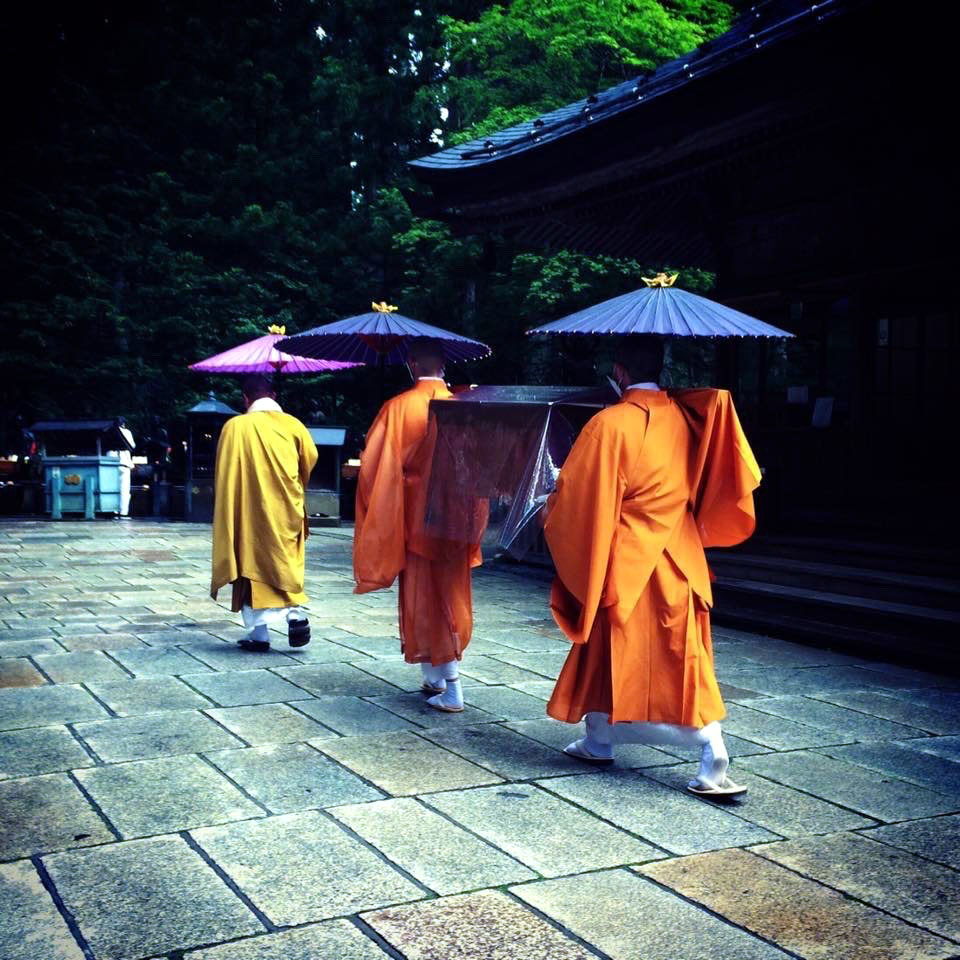
In Okunoin, there is a mausoleum where Kukai entered into nyujo (a state of deep meditation, where one becomes a Buddha while still alive). It is believed that Kukai is still alive on Mount Koya, and twice a day, at 6 AM and 10:30 AM, meals are brought to Okunoin. This ritual is called “Shojingu.” Until June 6th, a special exhibition was held at the Nara National Museum to commemorate the 1250th anniversary of Kukai’s birth, attracting over 100,000 visitors. Kukai, who
still gathers many devotees, was born in 774 in Sanuki, Shikoku. At the age of 31, he fulfilled his long-cherished wish to become an envoy to Tang China, aiming for Chang’an. The journey was unimaginable: 31 days by sea and 2400 km by land. Among the envoys was Saicho, who later founded the Tendai sect. Saicho was an envoy under imperial command, while Kukai was merely a practicing monk. Kukai had already mastered Chinese and completely mastered Sanskrit during his two-year stay in China. Kukai’s mentor, Master Huiguo, was the highest authority on esoteric Buddhism in China at the time. He recognized Kukai’s character upon their first meeting and devoted himself entirely to teaching him. Two years later, Kukai was chosen as Huiguo’s successor, surpassing other disciples, despite being a foreigner. After two years of training, Kukai
returned to Japan and established Mount Koya as the sacred site of Shingon Esoteric Buddhism as Huiguo’s successor. Mount Koya, which Saicho sometimes visited to seek Kukai’s teachings, now has about 200,000 graves. Among the notable figures interred there are Oda Nobunaga, who tried to attack Mount Koya, Toyotomi Hideyoshi, and Date Masamune, all famous “Warring States
period” generals. Additionally, there are memorial towers for the founder of the Jodo sect, Honen, and the founder of the Jodo Shinshu sect, Shinran. Both allies and enemies, and even different sects, are accepted here.
奥の院には空海が入定(瞑想をして生きたまま仏になること)した御廟があります。高野山では空海は今も生きているとされていて、奥の院には毎日朝6時と10時半の2回、食事が運ばれています。この儀式は「生身供(しょうじんぐ)」と呼ばれています。この6月6日まで、奈良国立博物館で空海の生誕1250年を記念して特別展が開かれ、10万人を超える入場者があったそうです。いまだに多くの信仰を集める空海は774年に四国讃岐に生まれます。31歳の時念願かなって遣唐使として中国長安を目指しました。海路31日、陸路2400㎞の想像を絶する行程でした。遣唐使の中にはのちに天台宗を起こす最澄もいました。最澄は朝廷の命を受けた遣唐使、空海は一介の修行僧でした。空海はすでに中国語はマスターしていて、中国留学中の2年間で梵語は完全マスターしたそうです。空海の師、恵果和尚は当時中国では密教最高峰の権威で、恵果は初対面で空海の人となりを見抜き、全身全霊をかけて教えを授けたそうです。2年後には他の弟子らを抑えて異国の地からやってきた空海を己の後継者としました。2年間の修業を経て帰国した空海は、恵果の後継者として真言密教の聖地として高野山を開きます。時には最澄まで教えを乞う為に訪れた高野山には、今では約20万基のお墓があり、 高野山を焼き討ちにしようとした織田信長 を始め、豊臣秀吉 、伊達政宗など名だたる「戦国武将」のお墓も所狭しと存在します。また浄土宗開祖「法然」の供養塔、浄土真宗開祖「親鸞」の霊屋まであり 、敵も味方も異宗派までもが受け入れられています。
